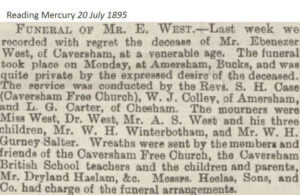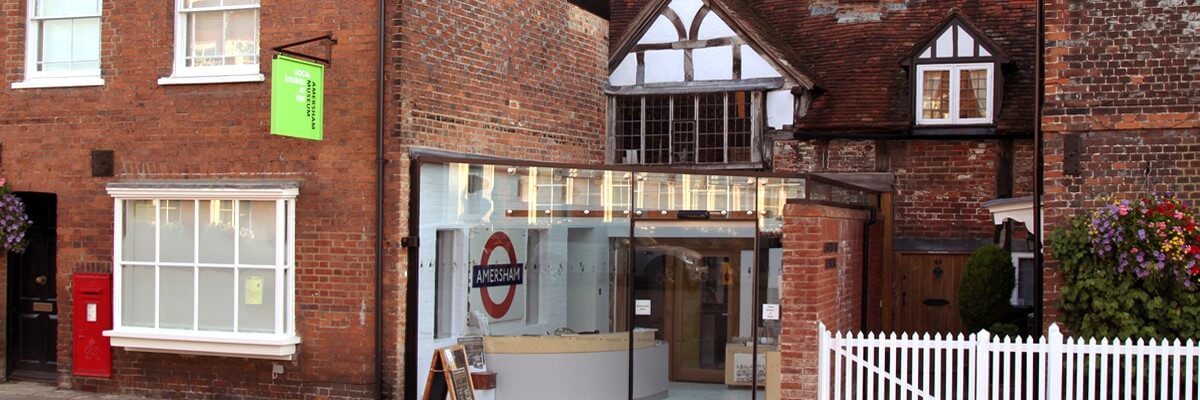THE ACADEMY TO EDUCATE THE SONS OF LIBERAL GENTLEMEN
This article was written by Dr Brooks and is reproduced with permission

This school existed at 42 High Street, Amersham (now Elmodesham House) from 1829 to 1861. It had its origin as a private school begun in The Manse of Chenies in 1821 by the Baptist minister, Rev. Ebenezer West, to educate his two sons Ebenezer and Charles, with four other boys under 12. By 1825 there were 12 pupils crammed into a tiny cottage next to Chenies chapel. This cottage is now called Kingscote. The pupils studied English, French, German and Mathematics. They were all boarders and were expected to bring a knife, fork and spoon and three towels which would be returned when they left the school. The fees were £25 per annum with £2 extra for washing! The school was a success but ran out of space in Chenies, so that the Rev. West had to search out better accommodation. He was able to take a long lease on 42 High Street in Amersham, which had been empty for five years. This house belonged to James Rumsey, who had been left it by his father, also James, a surgeon, who had practised there.
The school had a difficult start. Rev. Ebenezer suffered from ill health so that his elder son Ebenezer II was obliged to take over the running of the school in 1830 at the tender age of 20! The Rev. West died at Chenies in 1836. His younger son, Charles, was to continue as a pupil until he became apprenticed to a local medical practitioner and apothecary named Gray. Charles wanted to study medicine at Oxford but was turned down as his father was a Baptist minister. He, however, went to St. Bartholomew’s Hospital, studied further on the continent and became the first paediatrician in England and established Great Ormond Street Hospital. Ebenezer Il made a great success of the Amersham school which became known as ‘The Academy to Educate the Sons of Liberal Gentlemen’.
By 1841 there were 39 boys at the school, all boarders, so that extra accommodation had to be provided in the small houses (still in situ) on the pathway leading to the Baptist Chapel. Most of the pupils came from non-conformist families, though later, some were admitted who came from other religious persuasions and also some day-boys. The Academy was so successful that attendance at Dr Challoner’s Free School dropped sharply.
Local Directories proved unhelpful in this research. Pigott’s Directory for 1842 and 1854 had entries under “Traders” stating “West Ebenezer Boarding High Street”. The 1851 census proved more helpful. Under 42 High Street it listed –
Ebenezer West Head of family
Martha West Wife
Fewster Johnson West Son
Alfred Slater West Son
This is followed by the names of 42 pupils and two assistant teachers and two housemaids. One of the pupils was William Weller, son of a well-known local family.
By 1858 the Academy numbers had risen to 54 pupils from all over the country including one from overseas. Ebenezer was permitted to carry out structural alterations to the main house, most notably the range of new classrooms projecting southwards from the kitchen at the west end, so that a courtyard was created behind the house.
Dr Challoner’s Free School had 16 pupils in 1851. The number was down to 9 by 1858, 4 by 1860 and only one in 1862. (The population of Amersham was then 3,100) Fortunately after the Academy moved to Caversham in 1861, Dr Challoner’s school made a gradual recovery, later to become Dr Challoner’s Grammar School.
The standard of education of the Academy gained a national reputation. Three past pupils later became Privy Councillors – Lord Couzens Hardy, Sir Andrew Scobell and Augustine Birrell, who became the President of the Board of Education. In 1854 former pupils of the Academy presented Ebenezer with a beautiful service of plate to mark their esteem.
Ebenezer realised by 1860 that he had problems. From 1852 he had been in support of a rail link to Amersham which had originally been planned by George Stephenson in 1835. Ebenezer chaired a meeting at The Griffin on 13th January 1853 to discuss the proposed route through the valley. Squire Thomas Tyrwhitt-Drake was not in favour. He did not want a railway within sight of Shardeloes. Ebenezer hoped that a railway would make it easier for him to attract more pupils for the Academy. The railway problem was not to be resolved for many years though the Academy numbers continued to rise and accommodation problems at 42 High Street were becoming more acute by 1861. Further building was difficult as the property was on lease.
Suitable new accommodation had been found in Caversham, Reading, and Ebenezer decided to move the Academy there in 1861. This allowed expansion to 100 boys. It became known as Amersham Hall and continued to be a successful school. Alfred Slater West took over the school from Ebenezer in 1876. It flourished until compulsory closure following a severe outbreak of Scarlet Fever in 1896. Ebenezer died in 1895.

Sources:
A History of Amersham. Julian Hunt
The Book of Amersham. Pike and Birch
Yesterday’s Town – Amersham, Salmon and Birch
The Social History of Chorleywood, Chenies, Loudwater & Heronsgate – 2007 Ian Foster
Records of Bucks. 37/141-158
Challoners 1624- 1974 History
Directories – Pigott. 1842 & 1854
Deeds of Elmodesham House

